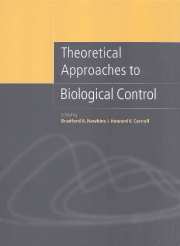Book contents
- Frontmatter
- Contents
- List of contributors
- Preface
- Part I Biological control theory: past and present
- Part II Ecological considerations
- 4 The uniformity and density of pest exploitation as guides to success in biological control
- 5 Biological control of insect pests: a tritrophic perspective
- 6 The case for indigenous generalists in biological control
- 7 Why is the parasitoid Encarsia formosa so successful in controlling whiteflies?
- 8 Parasitoid adult nutritional ecology: implications for biological control
- 9 Coexistence of multiple attractors and its consequences for a three-species food chain
- Part III Spatial considerations
- Part IV Genetic/evolutionary considerations
- Part V Microbes and pathogens
- Index
8 - Parasitoid adult nutritional ecology: implications for biological control
from Part II - Ecological considerations
Published online by Cambridge University Press: 13 August 2009
- Frontmatter
- Contents
- List of contributors
- Preface
- Part I Biological control theory: past and present
- Part II Ecological considerations
- 4 The uniformity and density of pest exploitation as guides to success in biological control
- 5 Biological control of insect pests: a tritrophic perspective
- 6 The case for indigenous generalists in biological control
- 7 Why is the parasitoid Encarsia formosa so successful in controlling whiteflies?
- 8 Parasitoid adult nutritional ecology: implications for biological control
- 9 Coexistence of multiple attractors and its consequences for a three-species food chain
- Part III Spatial considerations
- Part IV Genetic/evolutionary considerations
- Part V Microbes and pathogens
- Index
Summary
Introduction
Biological control practitioners have for long appreciated that food consumption by adults is likely to affect the impact of parasitoids on pest populations (see Jervis et al., 1996a,b). Over the past decade, parasitoid feeding behavior has aroused the interest of ecologists, and new insights have been gained into parasitoid feeding ecology that have important implications for biological control. In the light of theory, we discuss parasitoid feeding behavior and ecology with respect to biological control strategies.
Feeding behavior
‘Ovigeny’ and dietary requirements
The females of pro-ovigenic species emerge with their near-to-full or full lifetime complement of mature eggs and therefore require little or no materials for egg production. However, those species that deposit their eggs over several days following eclosion are likely to require materials to fuel their locomotory and somatic maintenance requirements, and so their lifetime reproductive success will depend on feeding. The females of synovigenic species eclose with either no mature eggs or just a fraction of the number that can potentially be matured during a lifetime, so they require materials for egg production as well as maintenance (Flanders, 1950; Jervis & Kidd, 1986; van Lenteren et al., 1987). Whether a species is pro-ovigenic or synovigenic will depend both on the extent of ‘carry-over’ of resources from the last larval instar to the pupa, and on the duration and metabolic costs of pupal development.
- Type
- Chapter
- Information
- Theoretical Approaches to Biological Control , pp. 131 - 151Publisher: Cambridge University PressPrint publication year: 1999
- 29
- Cited by



